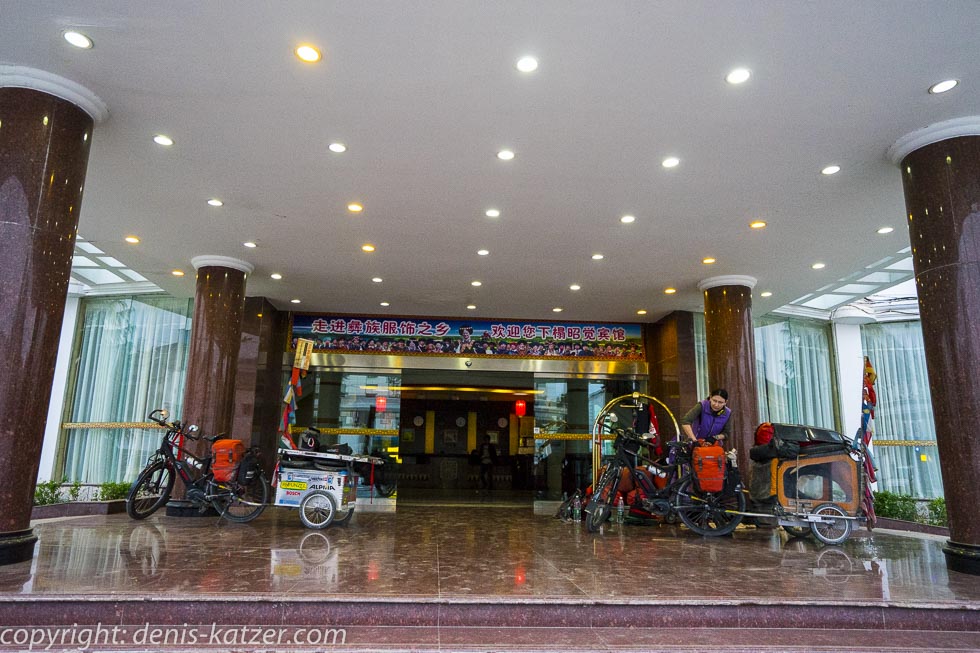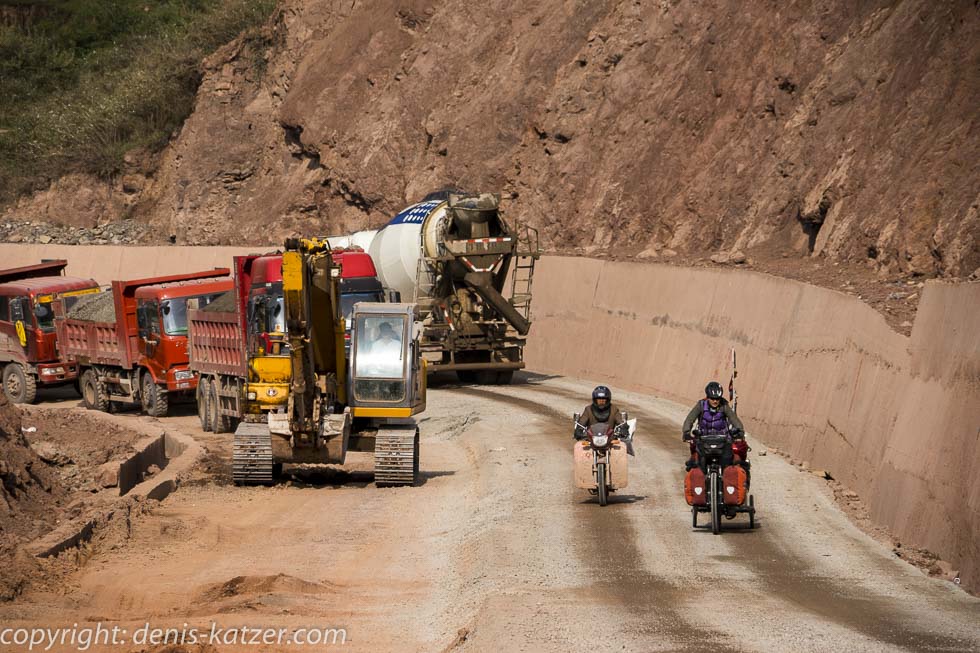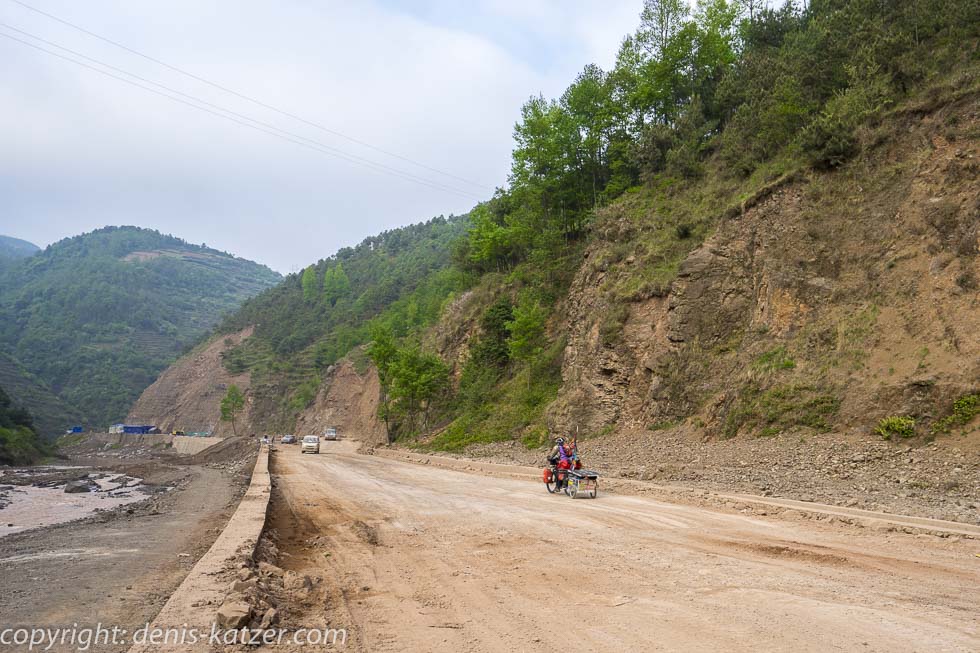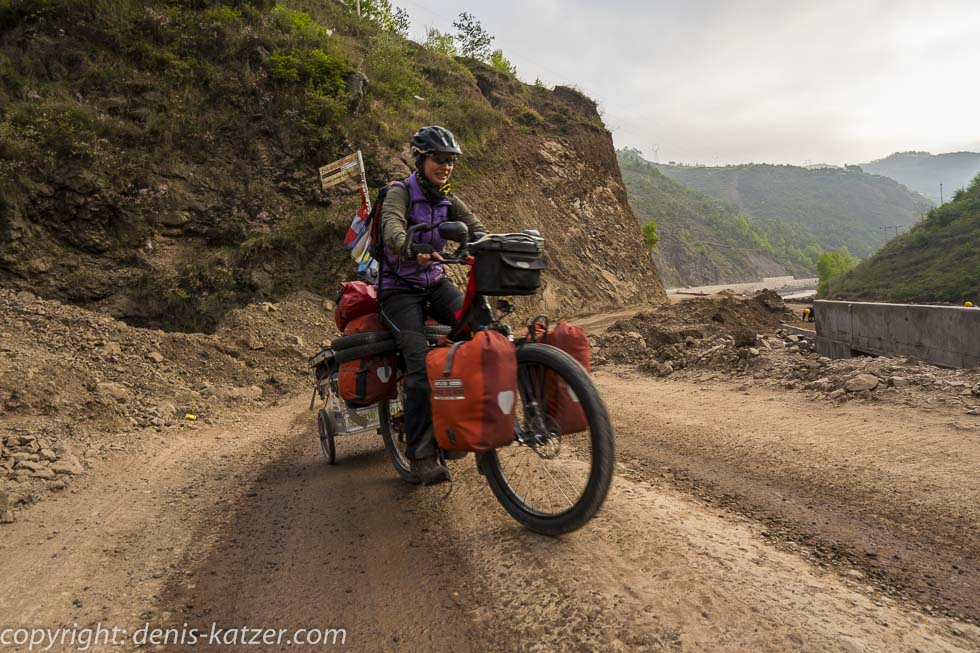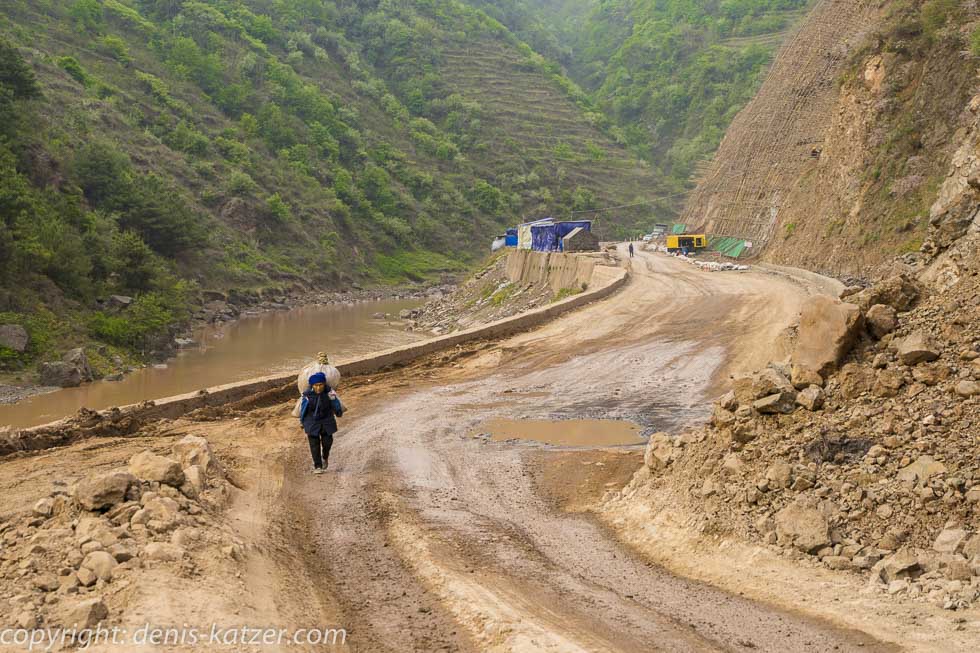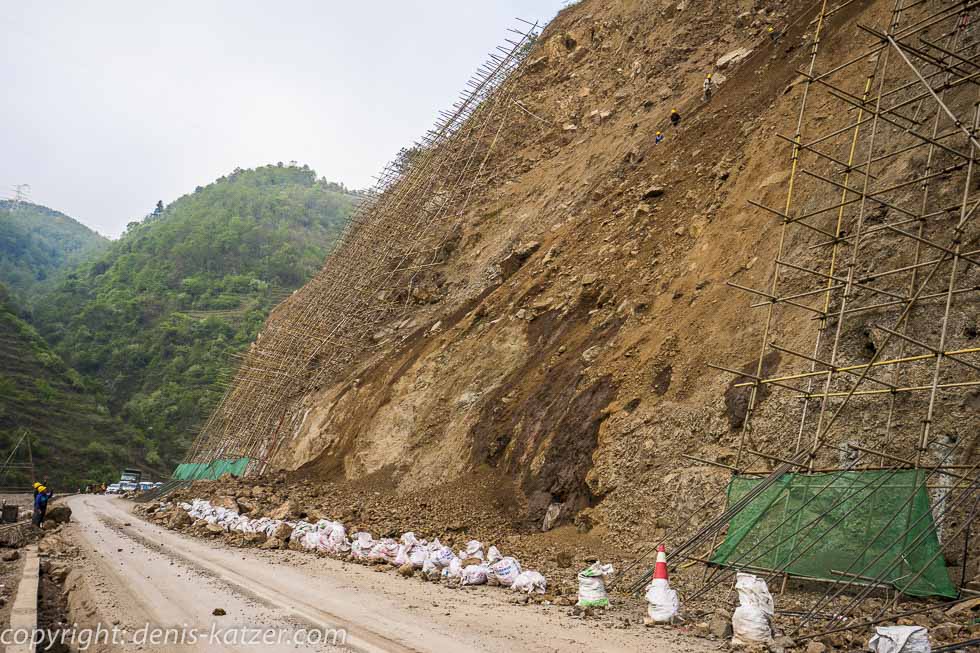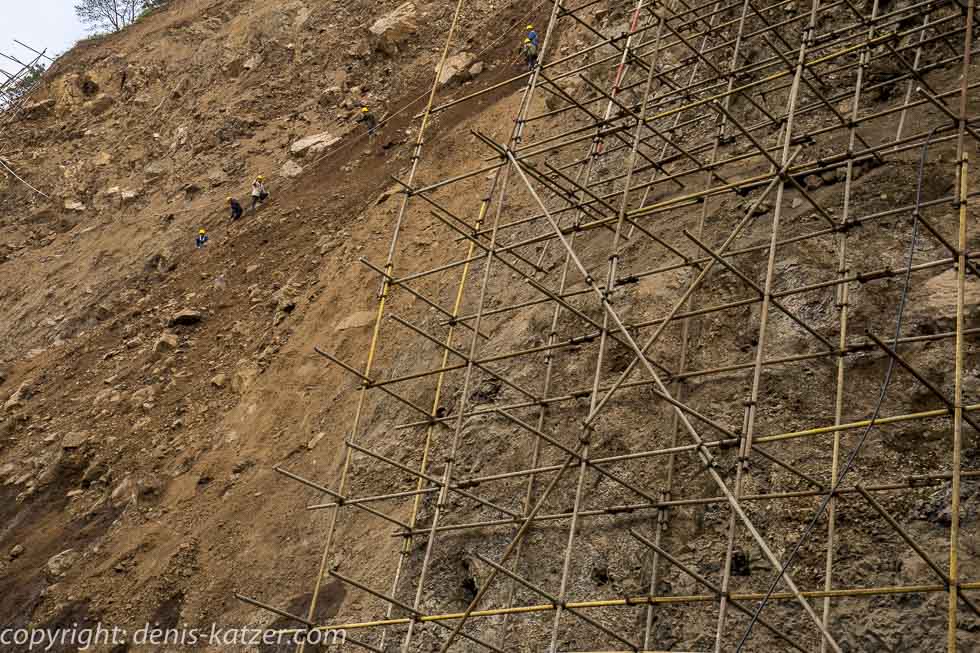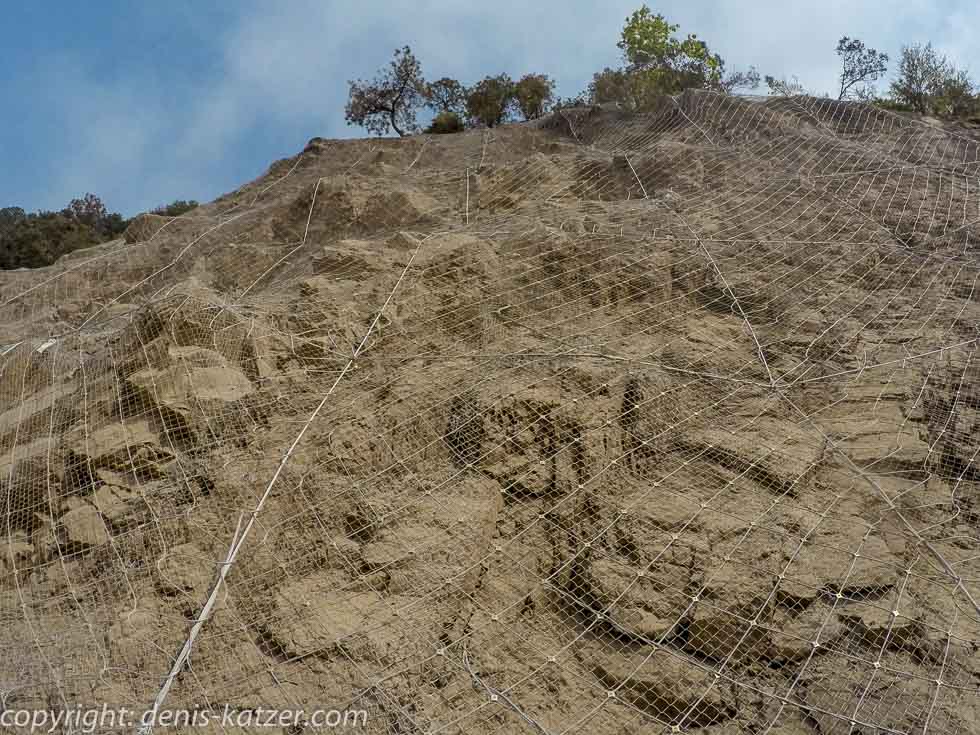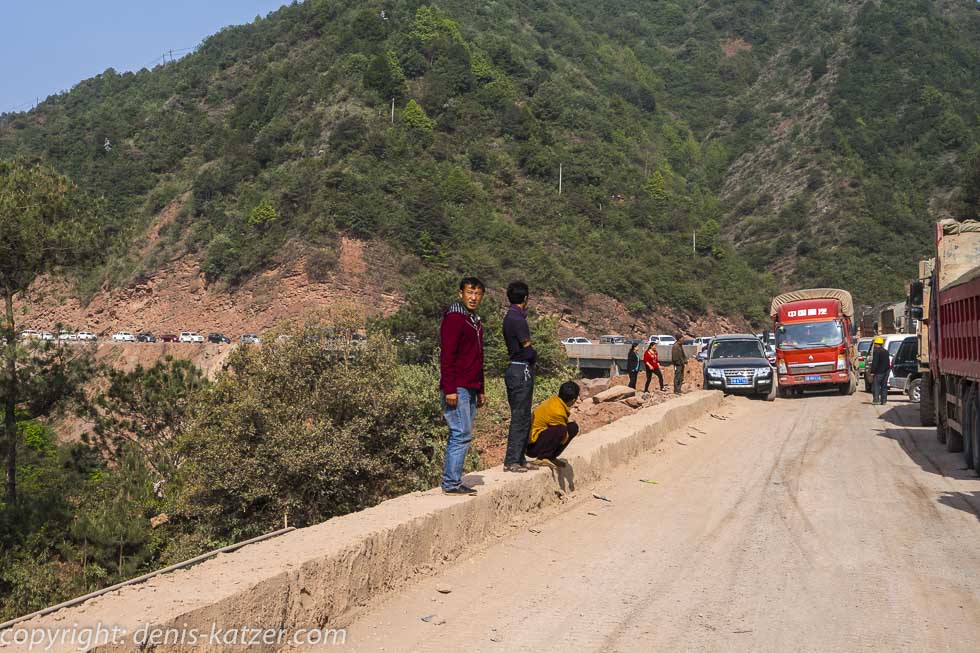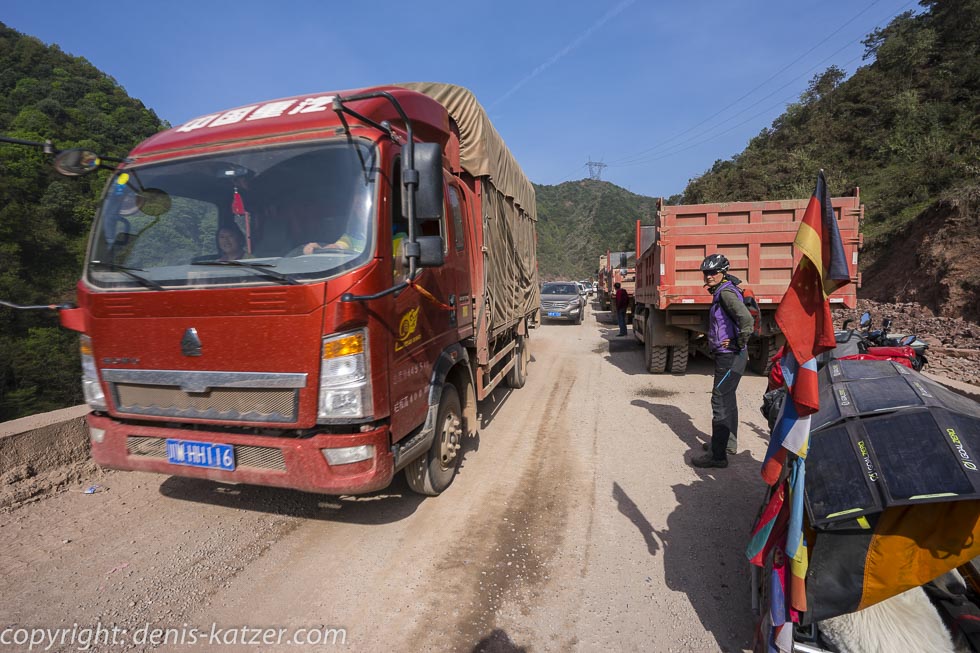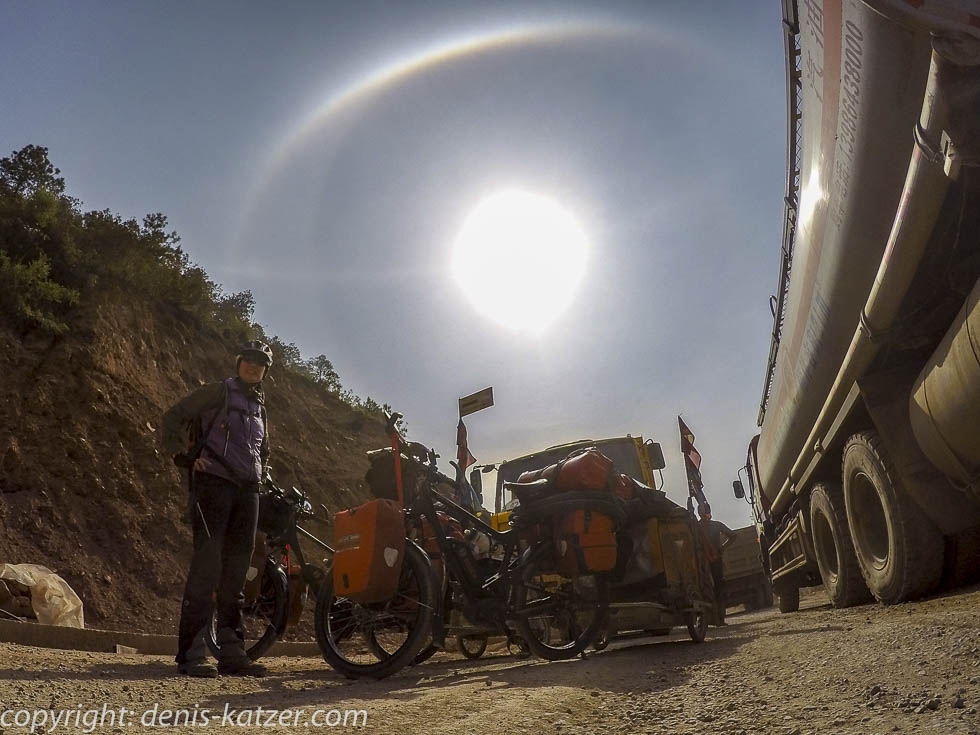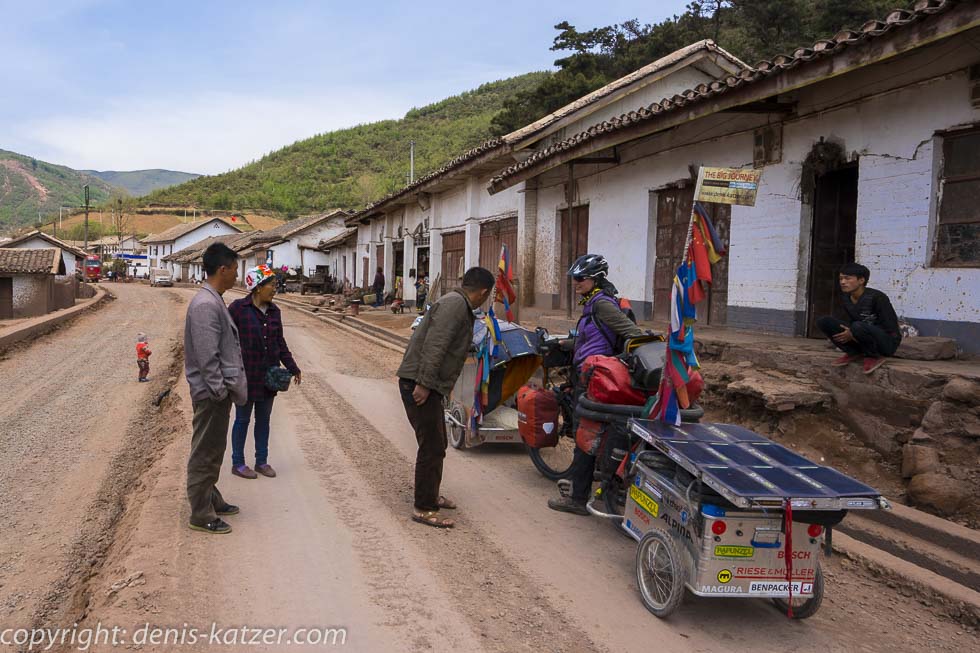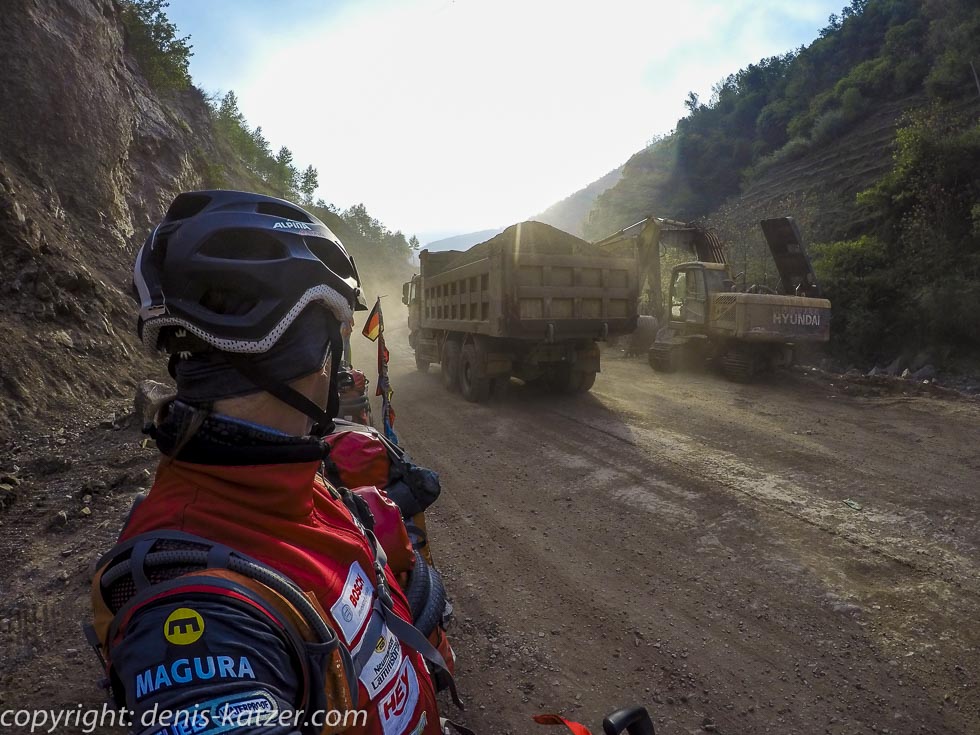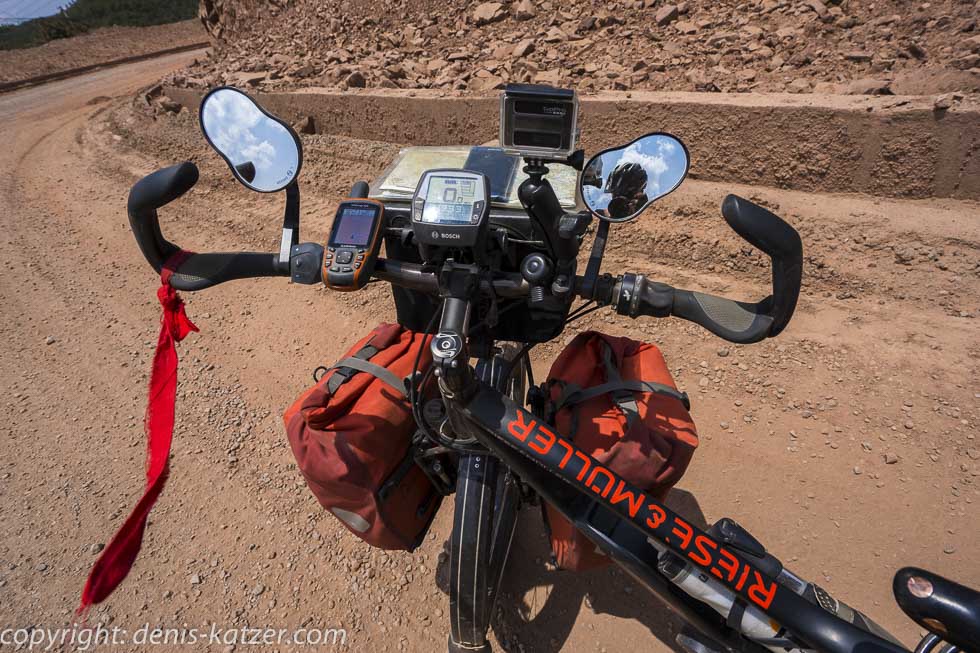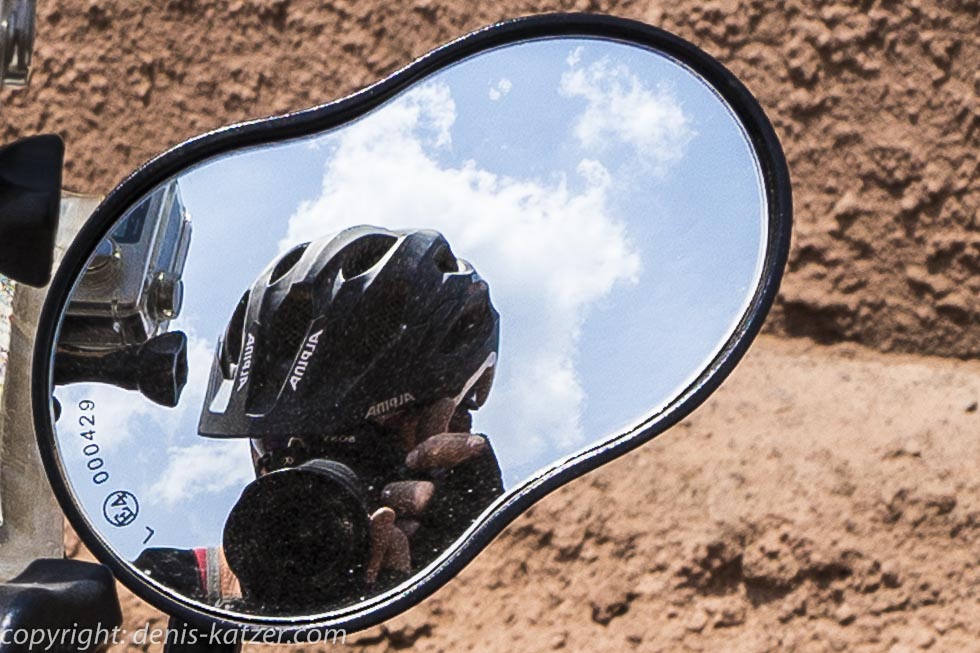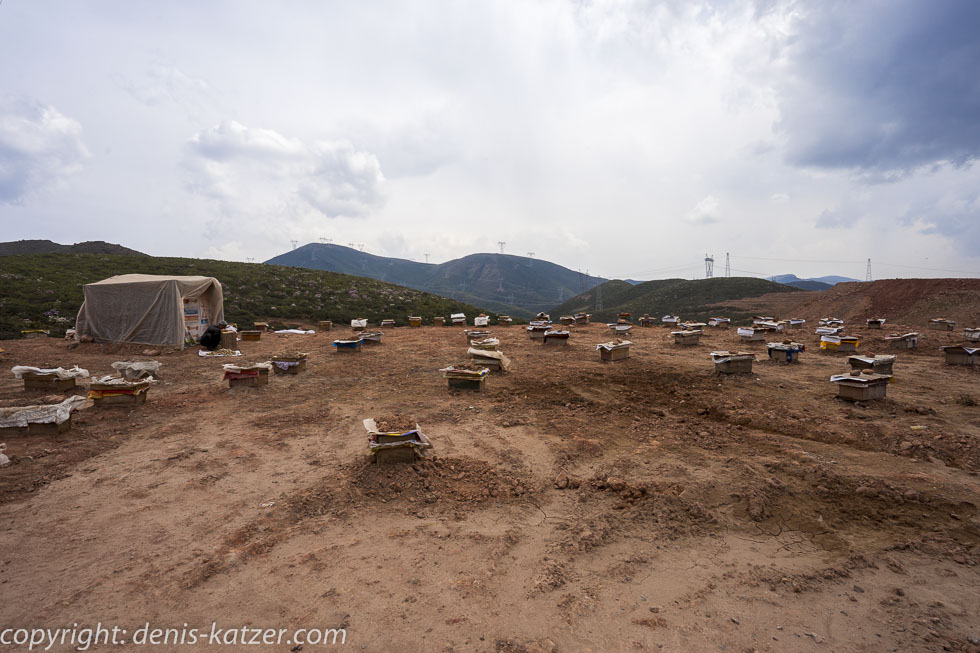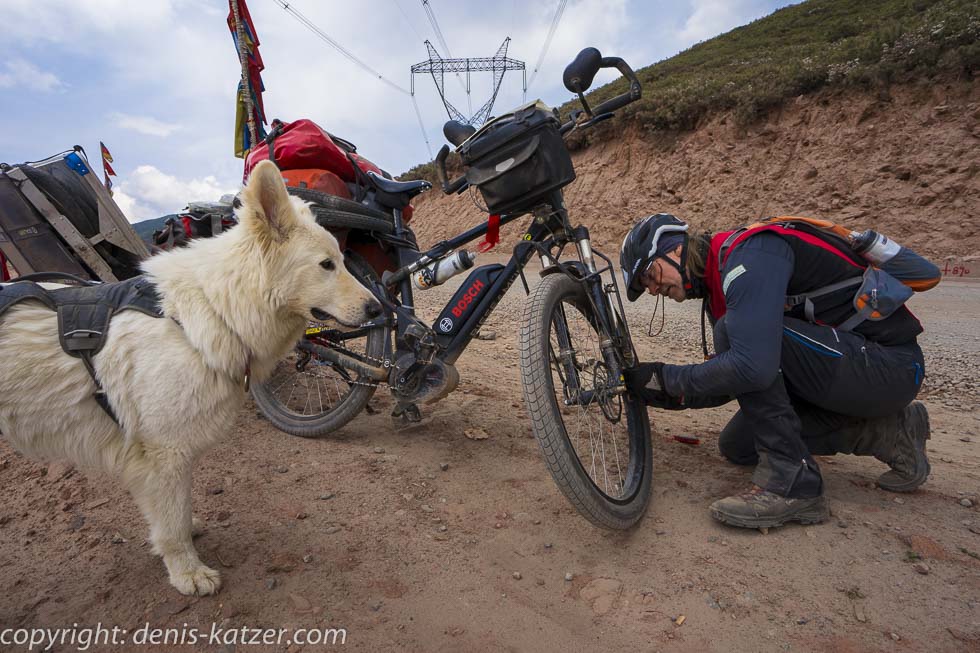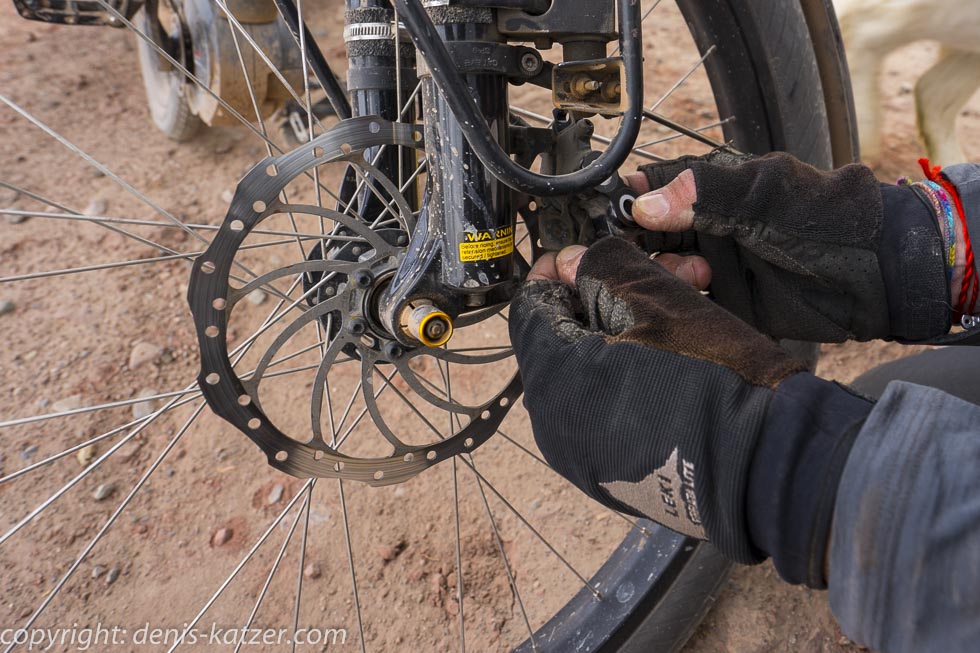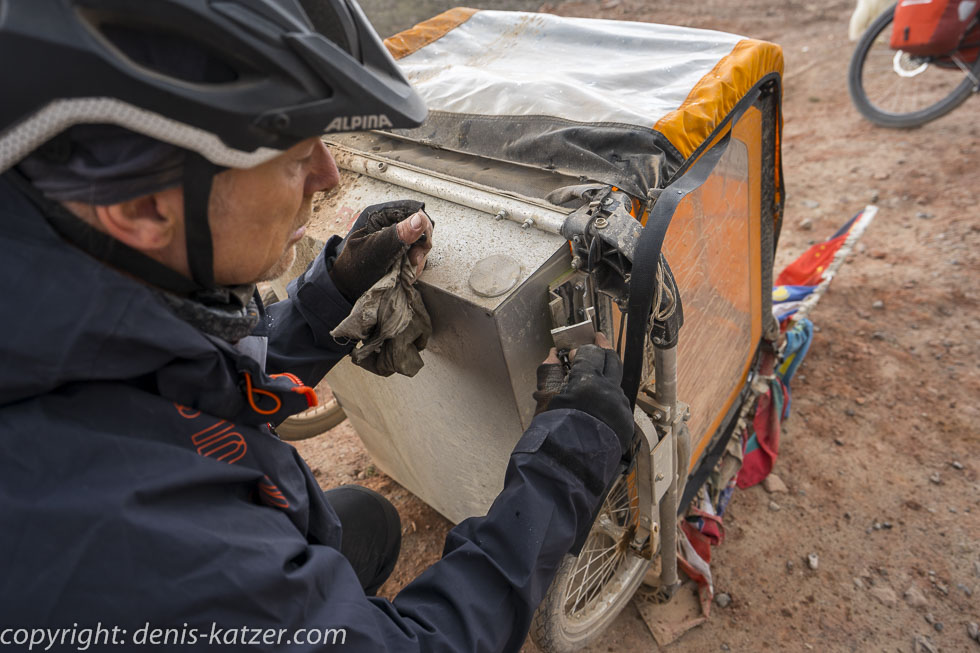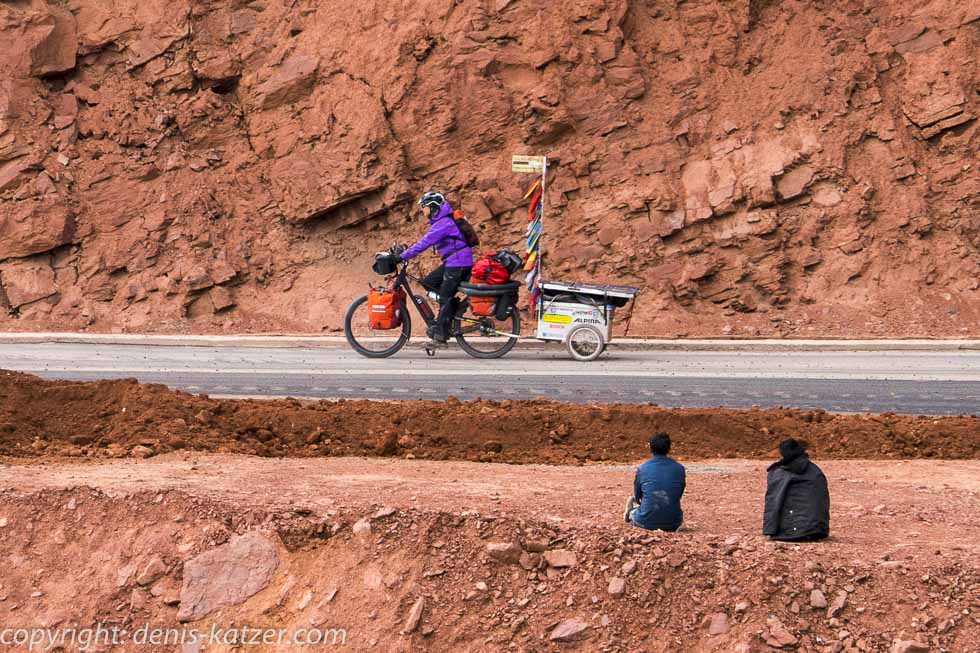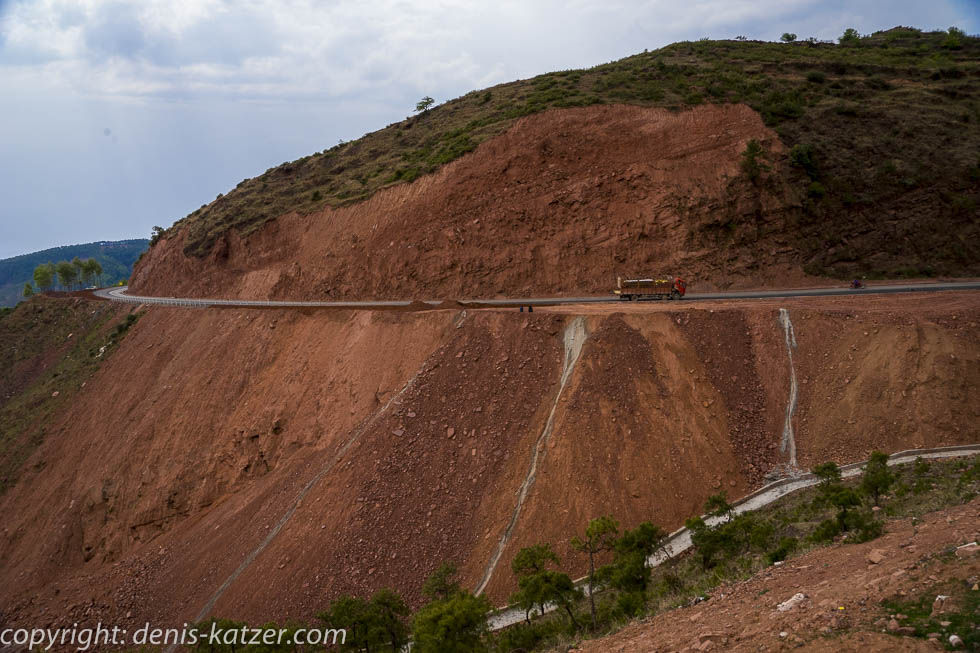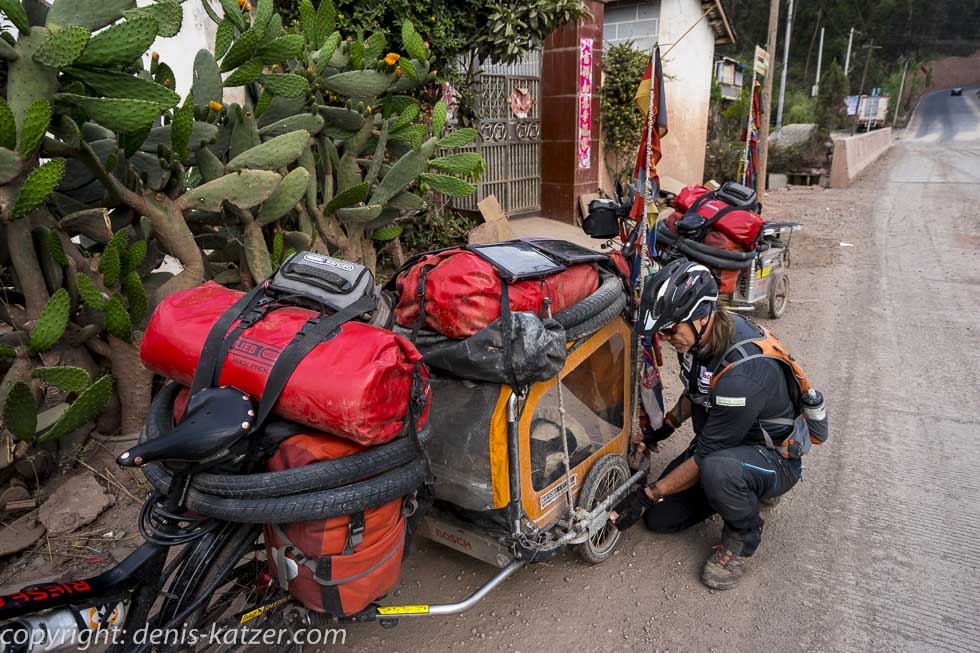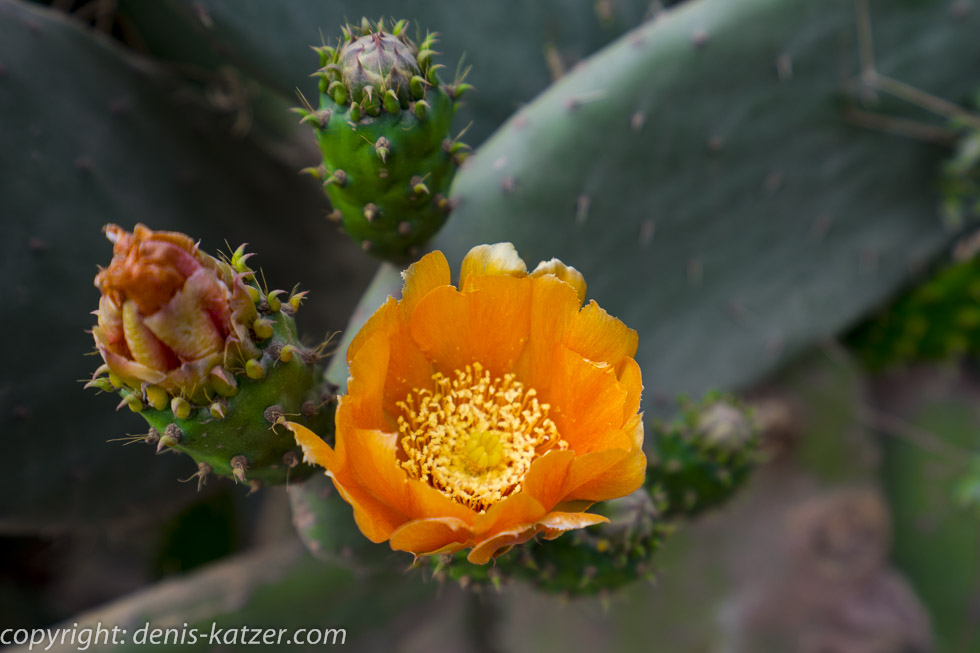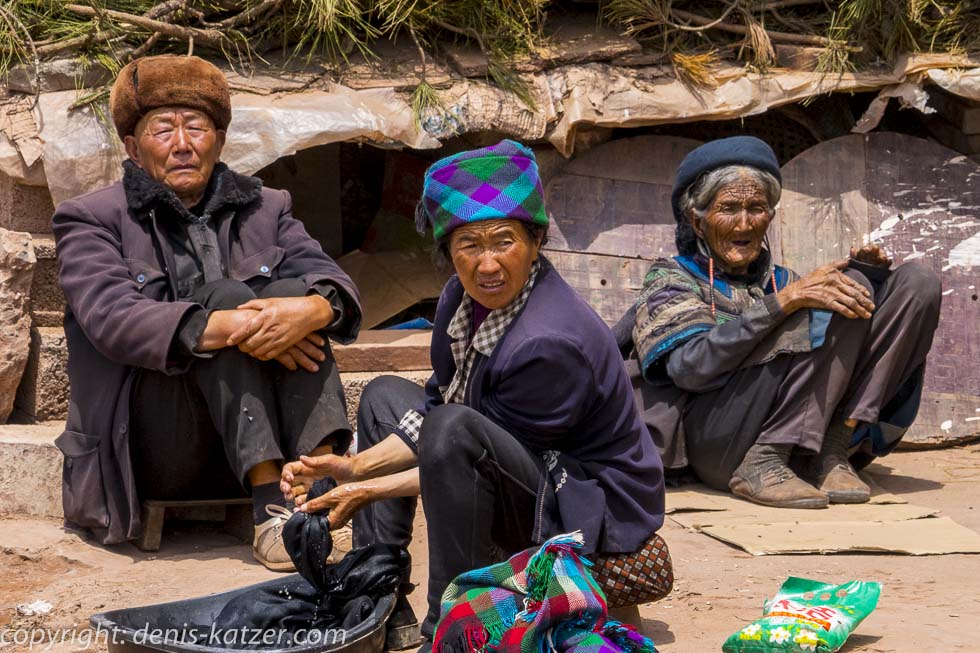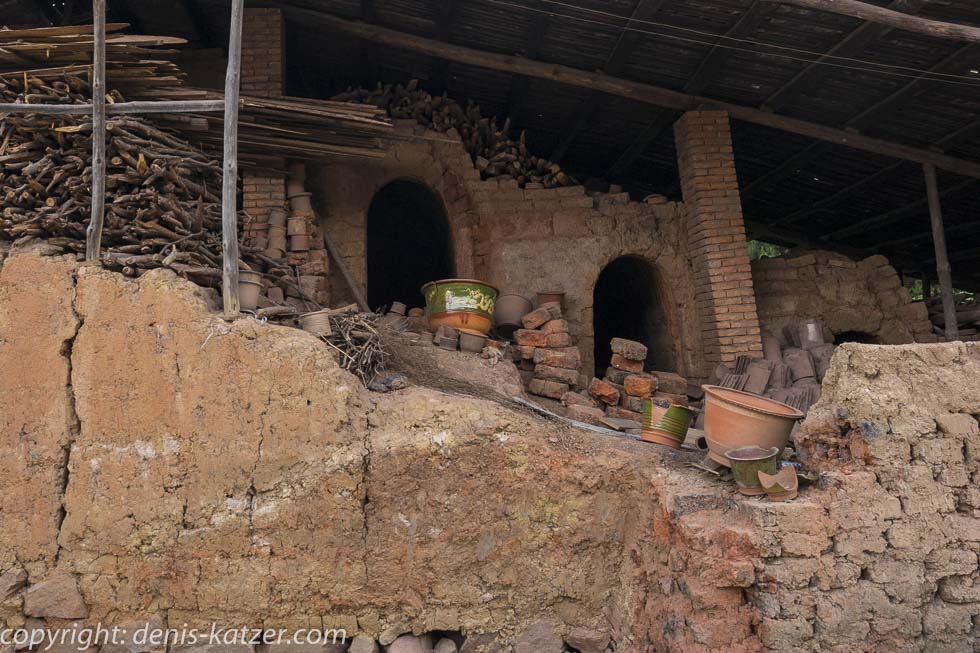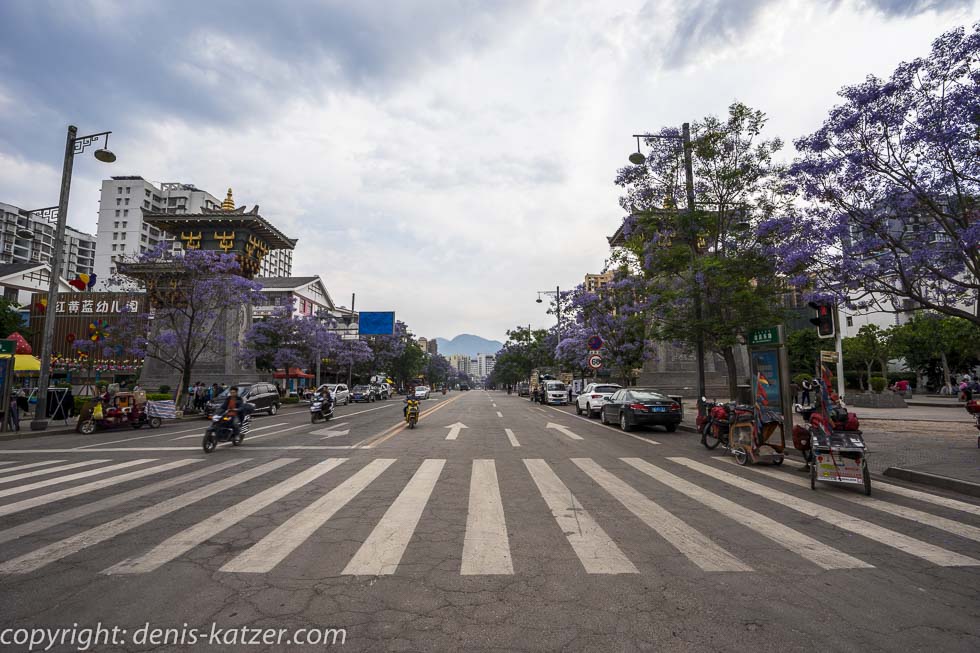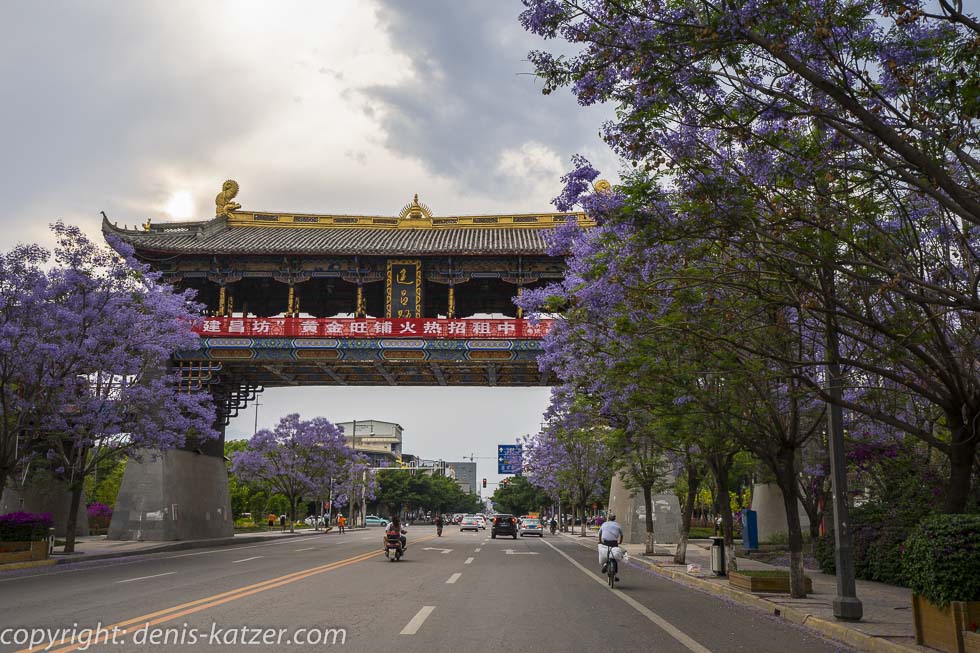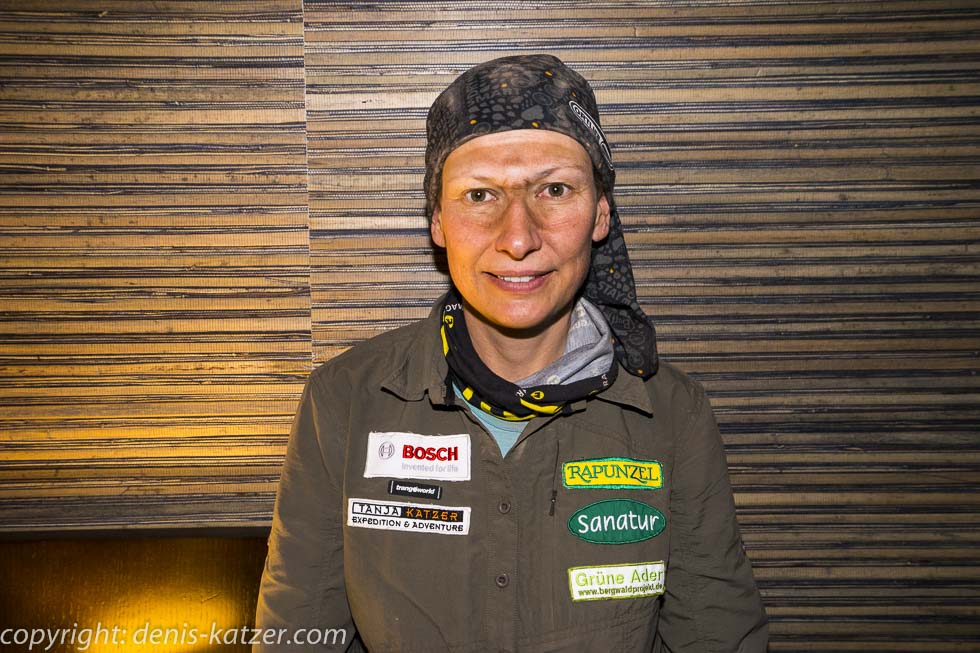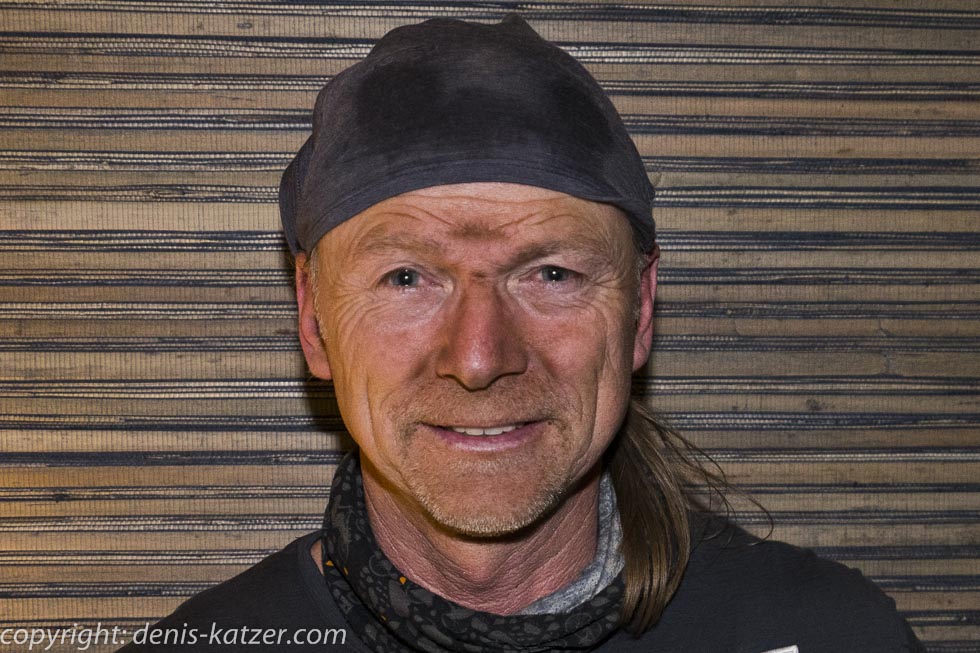
At an altitude of 3,300 meters, gravel road, breakdown and heavy thunderstorm
N 27°53'30.2'' E 102°14'14.0''
Date:
03.05.2016 until 04.05.2016
Day: 311 – 312
Country:
China
Province:
Sichuan
Location:
Liangshan
Latitude N:
27°53’30.2”
Longitude E:
102°14’14.0”
Daily kilometers:
95 km
Total kilometers:
16,524 km
As the crow flies:
61.5 km
Average speed:
15.3 km/h
Maximum speed:
55.6 km/h
Travel time:
6.09 hrs.
Soil condition:
Ballast
Maximum height:
3.300 m
Total altitude meters:
32.288 m
Altitude meters for the day:
1.474 m
Sunrise:
06:30 am – 06:29 am
Sunset:
7:45 pm – 7:46 pm
Temperature day max:
30°C
Temperature day min:
10°C
Departure:
07:00 a.m.
Arrival time:
7:00 p.m.
(Photos of the diary entry can be found at the end of the text).
After just a few kilometers, the announced roadworks begin. The road suddenly turns into a potholed gravel and clay track. Workers hang in the blasted steep slopes and use pickaxes and shovels to loosen any boulders that are not stuck. They roll down with a deep thud and hit the road not far in front of us. A man standing on the slope stretches his hand forward. Traffic is stopped for safety reasons. Steel scaffolding clings to some of the rock faces and extends to their upper ends. Concrete mixers rattle and are fed incessantly by numerous shovels. In order to protect the pass road from further rockfall and debris avalanches, road workers use flexible twenty-centimeter-thick hoses to blow liquid cement onto the rock faces. Other steep walls are spanned with steel nets. We stand with our small bikes next to hundred-meter-high mountain slopes that have been worked by humans. We watch in amazement at what the Chinese are doing here to turn a life-threatening mountain road into a safe traffic artery.
Waving, the man clears the traffic. We start pedaling. The engines of heavily laden trucks roar ahead and behind us. Because only one lane is passable, we feel squeezed between them. They are literally hanging off our mudguards, unable to overtake us because of the narrow road and we have no way of avoiding them. Tanja is panting after me with a bad cold. Conditions are particularly tough for them today. Our bikes rumble over the terrible, destructive surface. I silently pray that nothing breaks. Excavators eat into the brown rock next to us, trucks are filled with it. We hurry past the steel colossi at intervals of just one meter, always up the hill. Suddenly nothing works anymore. Traffic in the high mountains is at a standstill in both directions. A car has a flat tire and is blocking a lane. The chaos is perfect. A kilometer-long queue of cars has formed uphill. Everyone pushes in our direction, while a whole convoy of construction machines, trucks and cars continues to work its way up until it is bumper to bumper. “I wonder how you’re going to untangle this tangle,” I wonder. Once again, we little people are standing between the trucks with our bicycle road trains, whose drivers are now laughing and chatting on the track. A civil engineer trudges up the potholed roadway, shouting orders into his walkie-talkie. From a distance, we can see parts of the queue of cars moving backwards. A gap is created into which the Jeep rolls with its broken tire. And indeed, after 30 minutes the avalanche of cars starts moving again. First it flows downhill for about 20 minutes and then, when nothing is coming towards us, the engines roar behind us. In the meantime, we have worked our way to the front of the queue of cars and trucks, so we form their head. This protects us from the enormous clouds of dust, some of which completely obscure our view. In turbo mode, we are panting ahead. Afraid of the screeching construction trucks, I pedal so hard that I leave Tanja far behind me. I only realize it when I turn around after a few minutes. A truck driver hangs on their heels. Too dense for her taste. When a small gap appears at the side of the road, Tanja lets him pass. He has won the tactical game for the lead and darts up the pass. Tanja’s tiredness is not rewarded. None of the following vehicles allows a cyclist to merge back in. The queue of metal cars is now mercilessly dusty and rolls past us until the last vehicle. The problem is that traffic is only released for one direction at a time. Once the uphill convoy is through, a construction worker on the other side clears the way for oncoming traffic. As we are barely registered in this madness, we have to try not to lose our place at the end of the queue. Otherwise we are pushed off the piste by the downhill skiers. I now develop a tactic of cycling in the middle of the gravel road to prevent anyone who wants to overtake us. In the end, the cars following us don’t slow down because the convoy jams up again at the next block of road anyway.
Although we started today at an altitude of over 2,000 meters, the track still leads upwards. At 3,000 meters, I take a few photos from my handlebars to record the altitude on the GPS. “After the bend up ahead, it’s probably going to go downhill again,” I say to Tanja, who is standing at the edge of the slope, sneezing and blowing her nose and struggling to get enough oxygen into her lungs because of the dusty air. “Phew, it’s exhausting today. Let’s rest a bit,” she huffs, whereupon we settle down on a rock in an open area. “You’ve caught a bad cold,” I say. “No wonder, a lot of people in Zhaojue had a cold.” “That’s right, I’m glad I was spared it this time. Just let me know when you’re well again. Then we’ll carry on. We still have 55 kilometers to go,” I say, biting into an apple and letting my eyes glide up the mountains. Suddenly I spot a flash. Is that a road up there?” I ask as it flashes again. “Oh no, we have to go up there?” I hear Tanja say. “The lightning is clearly a reflection of the sun’s rays when they hit something shiny. I’m sure it’s cars, which means that this nasty slope leads even further up into the sky,” I reply.
Despite the altitude, it is hot. We sweat like racehorses as we cross the finish line. Apparently the pleasant cycling temperatures are over. Beekeepers have built their apiaries next to the mountain road. Thousands of small black specks buzz through the air. “Close your mouth, otherwise you’ll get hit!” warns Tanja.
At an altitude of 3,300 meters I change Tanja’s brake pads. With the extreme ups and downs, the brake disks quickly slip off. Regular checks guarantee a longer life. We’ve already been bumping over the scree for six hours today. A tremendous load limit for our bikes and trailers. Then it’s finally downhill. I pass Tanja slowly because of the gravel, clay and endless potholes. “The trailer drawbar looks funny!” I hear her warning cry. “What? Please, not again,” I say, pull the brakes, put the bike on the stand and examine the heavy-duty drawbar. Fortunately, it’s okay, but I’m shocked to discover that the drawbar bracket on Ajaci’s caravan is broken again. “I’m glad you noticed,” I say thoughtfully. “Do we still have a spare bracket with us?” asks Tanja “Yes, we had two of them sent to us,” I reply and set about repairing them straight away. While I rummage through our spare parts store in Tanja’s trailer to find the bracket, heavy storm clouds roll over the top of the mountain. “Doesn’t look good,” says Tanja. “Not good at all.” “Will there be rain?” “Sure,” I say as the first lightning flashes through the wall of clouds. “Not a good place for a repair,” says Tanja, pointing to the high power pylon under which we are standing. “Maybe the storm won’t pass directly over us,” I hope and hurry to unscrew the broken part, my fingers trembling with excitement. Suddenly, heavy hail sets in. “We have to put on our rain jackets!” Tanja shouts against the squalls sweeping across the plateau. Tanja slips her jacket over me while I continue my feverish repairs. “Get in!” she calls, pointing to the open special trousers, whose side zippers can be opened up to the waistband so that they can be put on in full gear. The hail hammers on our helmets and shoulders. The ground is softened within a few minutes. Everything sinks into the mud. “What a mess! Now I’ve dropped my mother!” I grumble, stressed out. “Here she is!” I hear Tanja say, fishing the little thing out of the mud. Don’t panic. Stay calm. I take a deep breath and try to calm down as the thunder gets louder. In the meantime, we have turned the dog trailer upside down to make it easier to fit the bracket. That way the nuts don’t fall out all the time and I can screw in the retaining screws more easily. Then I have a flash of inspiration. One half of the broken drawbar bracket fits exactly as a spacer between the drawbar bracket and the floor pan. “If I can somehow manage to get the part in there, the drawbar bracket might not break. “That would counteract the shearing forces that arise at this point,” I say. “Why is it broken again? Apart from Ajaci, we only have two mats left in the roof rack,” asks Tanja. “Well, look at the roads. It’s certainly not a bad thing, but we’d need a tank for these conditions,” I reply, slowly starting to shiver from the cold. Tanja is also shivering and her body trembles as she sneezes violently. “Cold?” I ask anxiously. “A little,” I hear her voice through the pounding of the hail. “We should film the hail,” she says. “Can’t, the GoPro isn’t in the waterproof housing. I only took it out a few days ago because it hardly records any outside noise in there,” I explain.
An hour later we are ready to go again. The drawbar bracket has been replaced. Another breakage is prevented by the temporary installation of a spacer. At least I hope so. The hail has stopped and came just in time to disrupt our repair work. I walk around the bikes and trailers again to check them for any other damage that may have been overlooked before the next descent. “Everything’s okay,” I reply. Then we slide down the first few kilometers over slippery, wet and extremely bumpy ground. We are both very tired. After about 60 km of gravel road or, more appropriately, dirt road, the road improves. It’s downhill for another 30 km. From 3,300 meters to 1,500 meters. We stop again and again to give our brakes a chance to cool down and to check Ajaci’s trailer. I am relieved. He holds. My brake cooling system, which I have set aside for the Chinese trucks, also works perfectly. Again and again I stand at the side of the road as a so-called service man, waiting for Tanja and when she arrives I spray a few squirts on the brake callipers with my water bottle. It hisses and steams, then it continues. After 95 kilometers and almost 1,500 meters in altitude, we reach our destination for today…
If you would like to find out more about our adventures, you can find our books under this link.
The live coverage is supported by the companies Gesat GmbH: www.gesat.com and roda computer GmbH http://roda-computer.com/ The satellite telephone Explorer 300 from Gesat and the rugged notebook Pegasus RP9 from Roda are the pillars of the transmission.
